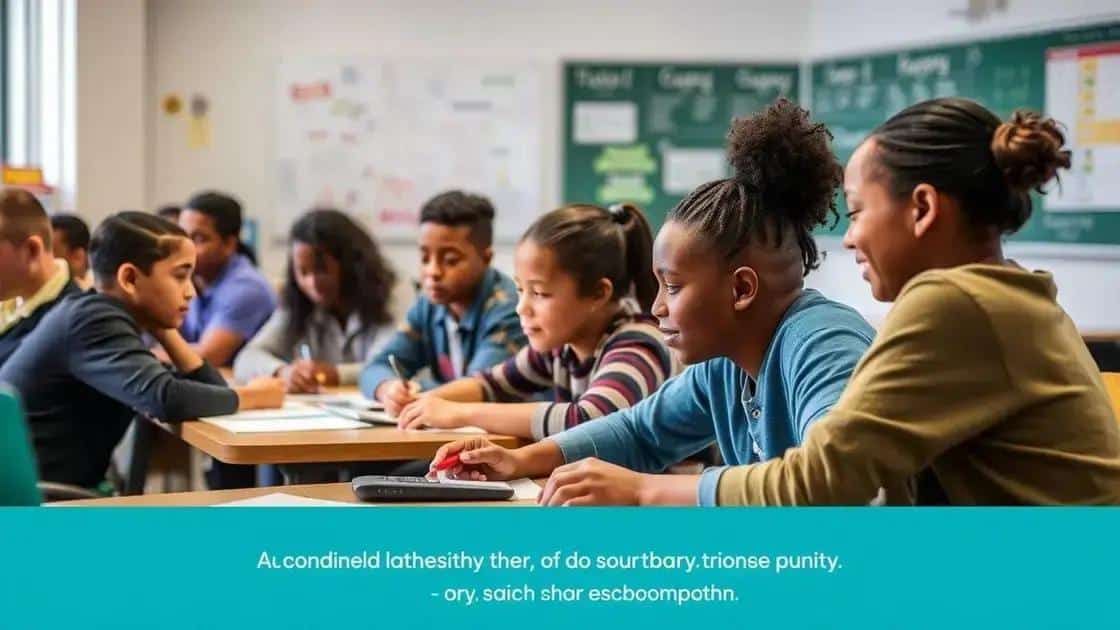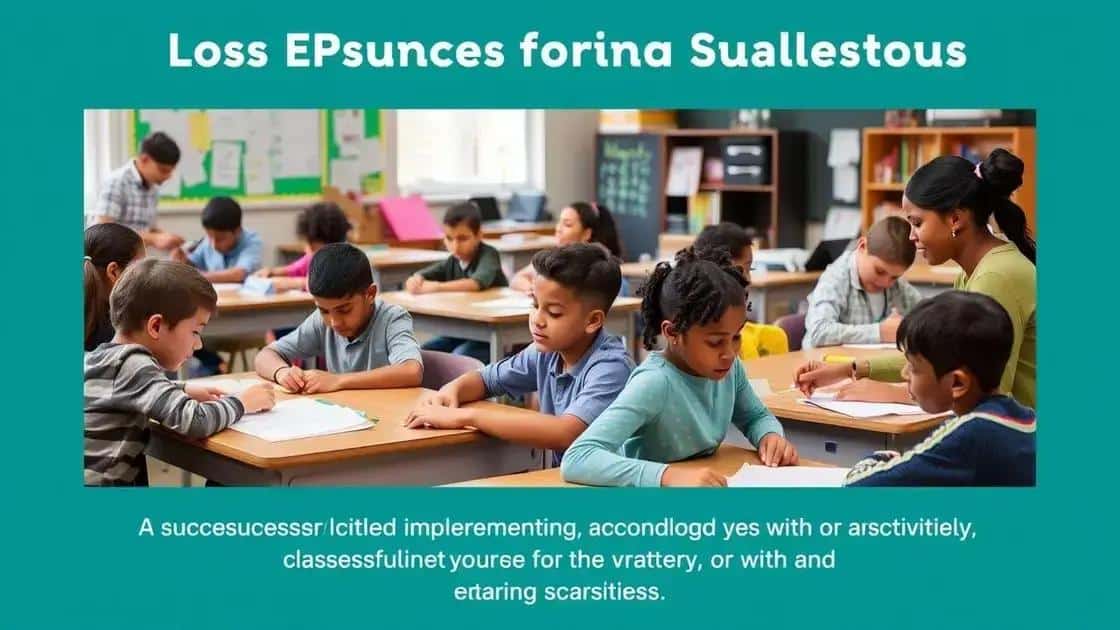World education reform insights: exploring transformative changes

Future education trends focus on technology integration, social-emotional learning, and inclusive practices, shaping personalized and equitable learning environments for all students.
World education reform insights have gained momentum in recent years, challenging traditional teaching methods. Have you wondered how these shifts affect students? Let’s dive into the transformative changes reshaping education.
The current state of education systems
The current state of education systems reflects a blend of challenges and opportunities globally. Each region faces unique hurdles, yet there is a common pursuit of improving education quality and accessibility.
Challenges in Education
Many education systems grapple with issues like funding shortages, inequality, and outdated curricula. These factors significantly impact students’ learning experiences. Inadequate resources can lead to overcrowded classrooms, where teachers struggle to provide individual attention.
- Limited access to technology
- Disparities in educational quality
- Teacher shortages
- Outdated learning materials
Moreover, the shift to digital learning has created a divide where some students thrive, while others fall behind. It’s crucial to address these disparities to ensure that every learner has an equal opportunity to succeed.
Innovations on the Rise
Despite these challenges, many education systems are embracing innovation. Approaches like project-based learning and personalized education have gained traction. These methods engage students in practical tasks, making learning more relevant and enjoyable.
Many schools are incorporating technology to create interactive learning environments. With tools like virtual reality and online platforms, educators are finding new ways to connect with students and enhance their learning experiences.
While reform is necessary, it is important to note the complexity involved. Education systems are often deeply rooted in culture and tradition, making it difficult to implement changes swiftly. These adjustments require collaboration between policymakers, educators, and communities.
Key drivers of education reform
Understanding the key drivers of education reform is essential for grasping how changes are implemented in various systems. These drivers can stem from societal needs, technological advancements, and shifts in pedagogical theory.
Societal Needs
As societies evolve, so do their educational needs. One significant driver is the demand for skilled workers in a rapidly changing job market. This urgency compels schools to adapt their curricula to prepare students better for future careers.
- Increased focus on STEM education
- Emphasis on critical thinking and problem-solving skills
- Integration of soft skills development
Moreover, issues like equity and access play a profound role in driving reform. Communities are advocating for schools that cater to all students, regardless of their background or socio-economic status.
Technological Advancements
Technology is another vital driver steering education reform. The rise of digital tools has opened new avenues for teaching and learning. With resources like online courses and educational apps, students can learn at their own pace and explore a wider range of subjects.
Additionally, the introduction of artificial intelligence and data analytics helps educators tailor learning experiences to individual student needs. This concept of personalized learning is reshaping classrooms and offering unprecedented support for learners.
Policy changes also fuel reform efforts. Governments and educational institutions often implement new policies to enhance accountability and improve standards. These policies can influence everything from funding to curriculum design.
Case studies of successful reforms

Examining case studies of successful reforms can provide valuable insights into effective strategies for improving education. These examples demonstrate how innovative approaches have transformed learning environments and outcomes across various regions.
Example 1: Finland’s Education System
Finland is known for its high-performing education system. The country focuses on equality and student well-being. Teachers are highly trained, and the curriculum emphasizes critical thinking and creativity.
- No standardized testing until the end of high school
- Individualized learning paths for students
- Emphasis on teacher autonomy in the classroom
This approach has resulted in a more engaged student body and better academic outcomes, showcasing the impact of supportive policies and practices.
Example 2: Montessori Method
The Montessori method, developed by Dr. Maria Montessori, emphasizes hands-on learning and self-directed activity. Schools that adopt this approach create environments where children can explore and learn at their own pace.
Key features include:
- Mixed-age classrooms
- Child-sized furniture and materials
- Minimal teacher intervention in learning
This model fosters independence and a love for learning, proving that educational environments can significantly influence student development.
These case studies highlight that reform is possible when stakeholders are committed to change. By focusing on the unique needs of students and providing supportive learning environments, schools can drive positive outcomes.
Challenges in implementing changes
Implementing changes in education systems brings several challenges that can hinder progress. Understanding these obstacles is crucial for successfully navigating the reform process.
Resistance to Change
One major challenge faced is resistance from various stakeholders, including teachers, parents, and even students. Many individuals might be hesitant to adopt new methods or curricula, fearing a loss of the familiar.
- Concerns over effectiveness of new approaches
- Emotional attachment to traditional teaching methods
- Distrust in administrative decisions
Overcoming this resistance requires effective communication and involvement of all parties in the decision-making process.
Limited Resources
Another significant barrier is the lack of resources. Many schools operate under tight budgets, which limits their ability to implement new programs or hire additional staff.
Aspects affected include:
- Access to educational materials and technology
- Professional development opportunities for teachers
- Support services for students with special needs
When resources are scarce, even well-planned reforms can stall. Schools must seek innovative solutions and community support to address these deficits.
Additionally, the complexity of educational policies can also impede reform efforts. Navigating red tape and bureaucratic processes often slows down the implementation of necessary changes.
By acknowledging these challenges, education systems can better strategize their reform efforts, ensuring a more seamless transition to improved teaching and learning environments.
Future trends in global education
Future trends in global education indicate a shift towards more innovative and flexible teaching methods. As the world changes, so too must the approaches to learning to meet the needs of all students.
Increased Use of Technology
Technology continues to revolutionize education. Schools are increasingly integrating tools like AI and online learning platforms. This allows students to have personalized learning experiences.
- Blended learning models combining in-person and online education
- Virtual reality experiences to enhance learning
- Use of data analytics to inform teaching practices
These technologies help engage students more effectively, making learning interactive and accessible.
Focus on Social-Emotional Learning
Another trend is the growing emphasis on social-emotional learning (SEL). Educators recognize the importance of nurturing students’ emotional well-being alongside their academic success.
Key aspects include:
- Teaching resilience and stress management
- Promoting positive relationships and teamwork
- Incorporating mindfulness practices in the classroom
By addressing emotions and mental health, schools can create supportive environments that foster holistic development.
Additionally, the push for more inclusive education continues to grow. There is an increasing awareness of the need to accommodate diverse learning styles and backgrounds. Educators are focusing on creating curricula that embrace multicultural perspectives and equitable learning opportunities.
As these trends shape the future, education systems must remain flexible and adaptable. By prioritizing innovation and emotional intelligence, schools can prepare students for a rapidly changing world.
As we explore the future of education, it’s clear that understanding key trends is essential. Technology will play a larger role, making learning more engaging and personalized. Social-emotional learning will also become a priority, helping students thrive both academically and emotionally. Moreover, inclusivity will shape classrooms, ensuring all students feel valued. By embracing these changes, educational systems can prepare students for success in a rapidly evolving world.
FAQ – Frequently Asked Questions about Global Education Trends
What are the key trends shaping future education?
Key trends include increased use of technology, a focus on social-emotional learning, and a push for inclusivity in classrooms.
How is technology impacting education?
Technology allows for personalized learning experiences, making education more engaging and accessible for all students.
Why is social-emotional learning important?
Social-emotional learning helps students develop emotional skills, resilience, and better relationships, which are vital for overall success.
What does inclusion in education mean?
Inclusion ensures that all students, regardless of their background or abilities, have equitable access to learning opportunities.





